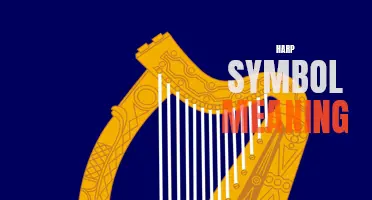
Germanic symbols have played a significant role in Germanic cultures for centuries. These symbols, often rich in meaning and steeped in ancient mythology, reflect the values, beliefs, and history of the Germanic peoples. From the runic alphabet that predates the Latin script to the various runes and sigils used for protection and divination, these symbols offer a fascinating glimpse into the intricate world of Germanic traditions. Whether they represent protection, strength, or the interconnectedness of nature and humanity, Germanic symbols continue to captivate and inspire people today, serving as a tangible connection to the past and a source of cultural identity.
What You'll Learn
- What are some commonly recognized Germanic symbols and their meanings?
- How do Germanic symbols differ from symbols found in other cultures?
- Are there any significant historical events or figures associated with Germanic symbols?
- What role do Germanic symbols play in contemporary German culture?
- How have Germanic symbols and their meanings evolved over time?

What are some commonly recognized Germanic symbols and their meanings?
Germanic symbols hold a deep cultural significance and are widely recognized for their rich history and symbolism. From ancient times to the present day, these symbols have played an important role in Germanic culture and continue to be celebrated and cherished.
One of the most iconic Germanic symbols is the Thor's Hammer, also known as Mjölnir. It is a symbol associated with the Norse god Thor, who was revered for his strength and protection. Thor's Hammer is often depicted as a heavy, short-handled war hammer, and it symbolizes power, bravery, and protection against evil. In modern times, it has become a popular symbol among those who seek to honor their Germanic heritage and connect with their ancestral roots.
Another renowned Germanic symbol is the Valknut, also known as the Odin's Knot or the Knot of the Slain. The Valknut is composed of three interlocking triangles, and its meaning is still a subject of debate among scholars. One interpretation suggests that it symbolizes the cycle of life, death, and rebirth, while others believe it represents the connection between the gods, man, and the cosmos.
The Helm of Awe, also known as the Ægishjálmur, is a symbol associated with protection and power. It is believed to have the ability to induce fear and awe in enemies, and it was often used by warriors to inspire courage and strength in battle. The Helm of Awe is depicted as an eight-armed radial symbol with a central point. It represents the ability to overcome adversity and challenges.
The Germanic Tree of Life, or Yggdrasil, is another symbol deeply rooted in Germanic mythology. Yggdrasil is often depicted as a gigantic ash tree that connects the nine realms of existence. It symbolizes the interconnectedness of all living things and the eternal cycle of life and death. The branches of the tree reach into the heavens, while its roots extend into the underworld, representing the harmony and balance of the universe.
The Wolf is a powerful symbol in Germanic culture, representing strength, intelligence, and loyalty. Wolves were revered by the ancient Germanic tribes for their hunting skills and their ability to survive in harsh conditions. The wolf is often associated with Odin, the chief god of the Germanic pantheon, and it symbolizes the fierce and untamed aspects of nature.
These are just a few examples of the commonly recognized Germanic symbols and their meanings. Each symbol carries its own unique significance and serves as a reminder of the rich cultural heritage and traditions of the Germanic people. Whether displayed as jewelry, tattoos, or art, these symbols continue to inspire and connect individuals with their Germanic roots.
The Fascinating Meaning Behind the Ollin Aztec Symbol
You may want to see also

How do Germanic symbols differ from symbols found in other cultures?
Germanic symbols are rich with history and symbolism, just like any other cultures' symbols. However, there are certain characteristics that set Germanic symbols apart from symbols found in other cultures.
One of the key differences is the use of runes. Runes are an ancient Germanic alphabet system consisting of characters made up of straight lines. These characters were not only used for communication but were also believed to possess magical properties. The Germanic peoples used runes for a variety of purposes, including divination, protection, and as symbols of power. Many Germanic symbols incorporate runes, giving them a unique and distinctive look.
Another notable difference is the use of animal symbolism. Germanic symbols often incorporate animal motifs, with animals such as wolves, bears, and eagles frequently appearing in their art and symbolism. These animals were believed to possess certain qualities and characteristics, such as strength, courage, and wisdom. They were often used as symbols of protection and power.
The Germanic peoples also placed great importance on the natural world, and this is reflected in their symbols. Elements such as trees, flowers, and rivers often feature prominently in Germanic symbols, representing the connection between humans and nature. The symbolism associated with these natural elements often reflects concepts such as growth, renewal, and the cyclical nature of life.
Furthermore, Germanic symbols often incorporate geometric patterns and shapes. These patterns can range from simple lines and circles to more complex and intricate designs. These geometric patterns not only add aesthetic appeal but also convey deeper meanings. For example, spirals may represent journey or transformation, while interlocking patterns can symbolize unity or interconnectedness.
Finally, Germanic symbols are deeply rooted in mythology and folklore. Many symbols are associated with specific gods and goddesses from Germanic mythology, and are used to invoke their powers and blessings. For example, the hammer of the god Thor, known as Mjölnir, is a popular Germanic symbol representing strength, protection, and the power to defeat enemies.
In conclusion, Germanic symbols differ from symbols found in other cultures due to their use of runes, animal symbolism, focus on the natural world, incorporation of geometric patterns, and their connection to mythology and folklore. These symbols not only have aesthetic appeal but also convey deep cultural meanings and beliefs. They serve as powerful tools for communication, protection, and the invocation of divine powers.
The Hidden Meaning Behind the Godsmack Symbol Revealed
You may want to see also

Are there any significant historical events or figures associated with Germanic symbols?
Germanic symbols have a long and rich history that dates back to ancient times. These symbols have been associated with significant historical events and figures, which have shaped the culture and identity of the Germanic peoples. In this article, we will explore some of these events and figures and their connection to Germanic symbols.
One of the most well-known Germanic symbols is the Valknut, also known as the "knot of the fallen." It is a three-sided interlocking triangle that represents Odin, the chief god in Norse mythology. Odin is associated with war, wisdom, and death, and the Valknut is believed to have been a symbol of his power. The Valknut has been found on ancient Germanic artifacts, including runestones and Viking ships, indicating its importance in their culture.
Another significant historical figure connected to Germanic symbols is King Arthur. While King Arthur is often associated with Celtic mythology, he also has ties to Germanic symbolism. The story of King Arthur and the Knights of the Round Table is believed to have originated in medieval Germanic folklore. The Round Table itself is a symbol of equality and unity among the knights, representing the Germanic concept of a close-knit community.
In addition to these figures, several historical events have been associated with Germanic symbols. One such event is the Battle of the Teutoburg Forest in 9 AD. This battle was fought between the Roman Empire and an alliance of Germanic tribes led by Arminius, a chieftain of the Cherusci tribe. Arminius used Germanic symbols such as the boar's head to rally his troops and inspire them to victory. This battle is considered a turning point in history, as it prevented the Roman Empire from fully conquering Germanic territories.
The Germanic symbols also played a significant role during the Viking Age. The Vikings were seafaring warriors and traders who raided and settled in various parts of Europe from the 8th to the 11th centuries. They had their own unique symbols, such as the Mjölnir (Thor's hammer) and the Vegvisir (a compass-like symbol). These symbols represented the Vikings' beliefs and provided them with protection and guidance during their voyages.
In conclusion, Germanic symbols have been associated with many significant historical events and figures. From the Valknut representing Odin in Norse mythology to the Germanic origins of the story of King Arthur, these symbols have shaped the cultural identity of the Germanic peoples. They have been used to inspire and rally troops in battle, symbolize unity and equality, and provide guidance and protection. Whether on ancient artifacts or in contemporary art, Germanic symbols continue to hold a deep meaning and significance for those who identify with the Germanic heritage.
The Deep Significance of Omega Symbol Tattoos Unveiled
You may want to see also

What role do Germanic symbols play in contemporary German culture?
Germanic symbols have a significant role in contemporary German culture. These symbols are often seen as a way to connect with the country's rich cultural heritage and history. They are used to express national pride and as a representation of German identity.
One of the most recognizable Germanic symbols is the Black Eagle, which has been a symbol of Germany since the Holy Roman Empire. The Black Eagle represents strength, power, and leadership, and is often seen in various forms across the country. It is featured on the German coat of arms and is used by many government institutions and organizations.
Another symbol that holds great cultural significance is the Oak Tree. The Oak Tree has long been associated with Germany and is seen as a symbol of strength, resilience, and endurance. It is often depicted in artworks, literature, and architecture as a representation of German values and identity.
The Germanic Runes are also a common symbol used in contemporary German culture. These ancient symbols were used by Germanic tribes in the pre-Christian era and are still used today as a connection to ancestral roots. The Runes are often seen as a form of ancient wisdom and are used in various forms of art, jewelry, and spiritual practices.
In addition to these symbols, Germanic mythology and folklore also play a role in contemporary German culture. Stories of Norse gods and heroes are still popular and are often featured in literature, film, and other forms of media. These stories are seen as a part of the cultural heritage and are used as a way to connect with the past.
Furthermore, Germanic symbols are also used in various festivals and celebrations throughout the year. For example, during the Oktoberfest, traditional Germanic symbols, such as the pretzel, beer steins, and Bavarian hats, are prominently displayed. These symbols create a festive atmosphere and help to reinforce cultural identity.
In conclusion, Germanic symbols have a significant role in contemporary German culture. They are used to express national pride, connect with the country's rich cultural heritage, and strengthen German identity. Whether it is the Black Eagle, the Oak Tree, the Runes, or Norse mythology, these symbols are an integral part of the German cultural landscape. They are used in various forms of art, literature, festivals, and celebrations, serving as a reminder of the country's history and values.
The Symbolic Meaning Behind Alligators: Unmasking Their Mystique
You may want to see also

How have Germanic symbols and their meanings evolved over time?
Germanic symbols have a long and diverse history. These symbols have been used by various Germanic peoples throughout history and their meanings have evolved over time. From ancient runes to modern-day symbols, Germanic symbols have played an important role in the culture, religion, and identity of Germanic peoples.
One of the most well-known Germanic symbols is the runic alphabet. The runes were used by Germanic tribes such as the Vikings and the Anglo-Saxons. Each rune had a specific phonetic sound and a deeper symbolic meaning. The runes were used for writing, divination, and magical purposes. They were inscribed on stones, weapons, and other objects of importance. The meanings of the runes varied depending on the context in which they were used.
Over time, the runic alphabet evolved and different regional variations developed. For example, the younger Futhark, which consisted of fewer runes, replaced the older Futhark in some areas. The meanings of the runes also evolved as the cultures and beliefs of the Germanic peoples changed. Some runes came to be associated with specific gods or goddesses, while others were used for protection, luck, or healing.
In addition to the runic alphabet, Germanic symbols also include various mythical creatures and gods/goddesses. For example, the hammer of Thor, known as Mjölnir, is a powerful symbol that represents strength and protection in Germanic mythology. The Valknut, a symbol of Odin, represents the connection between life, death, and the afterlife. The Tree of Life, known as Yggdrasil, is another prominent symbol in Germanic mythology, representing the interconnectedness of all things.
In modern times, these Germanic symbols have taken on new meanings and become popular in various subcultures. With the rise of neo-paganism and the revival of Germanic mythology, these symbols have gained new significance. They are used by modern pagans, neopagans, and followers of Germanic-inspired religious movements. Some see these symbols as a way to connect with their ancestry and cultural heritage, while others use them as a form of self-expression or a way to show solidarity with a certain group.
However, it's important to note that Germanic symbols, like any symbols, can be easily misconstrued and misused. Some extremist groups have appropriated Germanic symbols for their own ideologies, tarnishing their original meanings. It's crucial to understand the historical and cultural context of these symbols and respect their origins.
In conclusion, Germanic symbols and their meanings have evolved over time. From the ancient runes of the Germanic tribes to the modern-day rediscovery and reinterpretation of these symbols, they have served as powerful tools of communication, spirituality, and identity. Today, these symbols continue to be cherished by many, representing a connection to the past and a way to express one's beliefs and values. However, it is important to approach Germanic symbols with respect and a deep understanding of their historical and cultural significance.
Understanding Nissan Maxima Dashboard Symbols and Their Meanings
You may want to see also
Frequently asked questions
The Valknut, also known as Odin's Knot, is a symbol commonly associated with the Norse god Odin. It is composed of three interlocking triangles and is thought to represent Odin's power and connection to the afterlife. Some also believe it is a symbol of protection and strength.
The Hammer of Thor, also known as Mjolnir, is one of the most well-known symbols in Germanic mythology. It is associated with the god Thor and is said to possess the power to protect and bless, as well as to create thunder and lightning. Many people wear replicas of Mjolnir as a way to show their allegiance to the old Germanic gods.
The rune Algiz, which looks like an upside-down letter "Y," is associated with protection and defense. It is often used in talismans and amulets to ward off harm and bring about a sense of safety and security. Algiz is also believed to represent spiritual awakening and connection to higher realms.
The Helm of Awe, also known as the Aegishjalmur, is a symbol commonly associated with protection and power. It is believed to have the ability to induce fear in enemies and to grant its wearer strength and courage. The Helm of Awe is often depicted as a spiky, circular design with eight arms radiating outward.
The rune Sowilo, which resembles a lightning bolt, is associated with the sun and is often seen as a symbol of positivity, success, and achievement. It is believed to bring about clarity, inspiration, and a renewed sense of energy. Sowilo is often used as a symbol of hope and personal growth.







